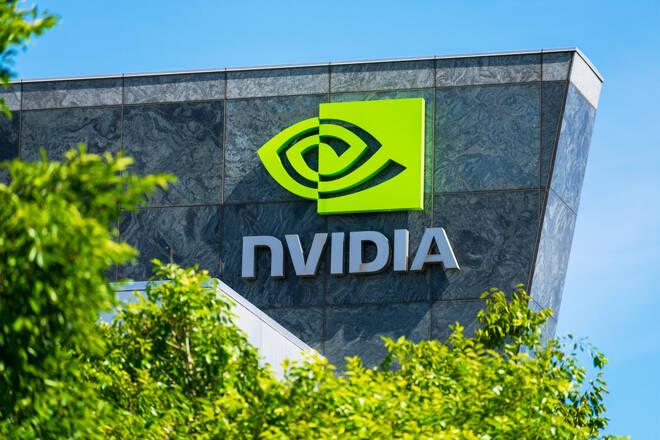Advertisement
Advertisement
SMH: Portfolio Rebalancing Is a Positive to Navigate Uncertainty While Metaverse Demand Materializes
By:
Chips are the building blocks of metaverses, be it Meta Platform (NASDAQ:FB) shifting its social networking platform into virtual reality (“VR”) or Jack Dorsey’s Block (SQ) looking to transform his FinTech company into more of a blockchain-oriented one.
The reason is simply that required technologies, be it augmented reality (“AR”), AI, 5G, or blockchain, all require the utilization of semiconductors. The pie chart below shows the relative revenue per sector, with Computing and Wireless with a combined portion of more than 60% seen as the main beneficiaries of metaverse-related investments.
Source: Chart prepared by author to highlight metaverse demand using data from IEEE Spectrum
For this purpose, the VanEck Semiconductor ETF (NASDAQ:SMH) provides exposure to a portfolio of semiconductor stocks ranging from the equipment makers like Applied Materials (NASDAQ:AMAT) to designers of graphics processing units like NVIDIA (NASDAQ: NVDA) who are fabless, or without foundries where the chip are manufactured. It also includes the world’s largest producer, Taiwan Semiconductor Manufacturing (TSM), which, according to the Wall Street Journal planned to raise prices by 10% to 20% back in August depending on the type of chips.
This is due to the supply crunch not only implying that chips have become unavailable, but more expensive too. The increases, expected to be applied towards the end of the year or from 2022 will also impact large customers, marking the end of discounts applied on big orders. The Taiwanese company also revealed that it faced a steep rise in the cost of raw materials and has to incur a three-year $100 billion investment plan aimed at increasing production in view of current shortages and developing chips.
Now, a change in the costs of raw materials in an industry already impacted by supply imbalance can have unforeseen effects on the price of finished goods, in the form of everything from consumer electronics, smartphones, Bitcoin mining equipment, cars, etc. Added to these are inflationary concerns not auguring well for next year. It is precisely here that portfolio rebalancing as effected by VanEck, SMH’s fund manager becomes handy.
In this case, with 25 holdings, SMH is an actively managed fund carrying an expense ratio of 0.35% and tracking the performance of the MVIS US Listed Semiconductor 25 Index (MVSMHTR), which provides exposure to semiconductor production and equipment. As for the rebalancing act, I noticed a crucial change between the holdings as of July 31 and December this year. The changes pertain to the percentage of assets for TSMC which has been reduced from 13.62% as shown in the table to the left to 9.89% (right-side table). This constitutes a significant reduction and is not only appropriate in an environment characterized by increasing geopolitical tensions between the U.S. and China but also to navigate short-term turbulence in the industry.
Source: Tables built with data from vaneck.com
Conversely, this reduction in TSMC’s assets has resulted in the portfolio being relatively more exposed to NVidia, thereby benefiting SMH’s price performance from the end of October (blue chart below). Now, whether its GPU-based computing power is produced for gaming or for crypto mining, the company should benefit from more sales in 2022, as long as it is able to source raw materials in a profitable way. Still, in the event that it is not able to do so, SMH as an ETF provides for investment diversification by encapsulating other plays in the chip ecosystem.
Another key player, Advanced Micro Devices (NASDAQ:AMD) could lessen chip supply woes by outsourcing some production to other foundries like Samsung Electronics (OTCPK:SSNLF), which is investing heavily in its foundry business in a bid to win more clients. Here, I also like VanEck cautiously increasing exposure to Intel (NASDAQ:INTC), from 4.66% to 5.14%, in light of the latter investing $20 billion to set up two plants in Arizona.
Source: Table prepared by author from data in finance.yahoo.com
Furthermore, as seen by the dotted blue line, the VanEck’s fund is on an upwards trajectory and should reasonably cross the $325 level in the first quarter of 2022, with this forecast supported by data from the Worldwide Semiconductor Trading Statistics which predicts that the market is expected to increase by 25.6% in 2021, and continue to grow by 8.8% in 2022. This prediction does not take into consideration chip requirements to build augmented reality around Facebook’s social media platform, Microsoft’s (NASDAQ:MSFT) work-oriented “metaspaces”, and blockchain-powered metaverses like Decentraland, which require enormous computing power for millions of digital coins to be mined (produced) and where virtual plots of land are priced at millions of dollars.
Pursuing on a cautionary note, investors should beware of short term volatility, especially in the first week of January 2022 when the Semiconductor Industry Association (“SIA”) which represents a large chunk of the U.S and foreign chip firms covering all regions of the world will reveal sales figures for the month of November 2021. In this case, any global or even major regional shortcomings may cause a dip in SMH’s, in contrast to the more than 5% surge on December 6, when the SIA announced upbeat news for the month of October.
Finally, with fewer holdings compared to the SPDR S&P Semiconductor ETF (XSD) but bearing the same expense ratio, SMH carries more concentration risks, but, despite all the volatility grappling the stock market in 2021, it has outperformed its peer by 2.38% during the last year. Consequently, looking forward to 2022, with a higher dose of market volatility to be potentially induced by factors like more intensive “metatalks”, geopolitics, Omicron spread, and regulatory scrutiny impacting cryptocurrency like Bitcoin, SMH is a better choice for the longer term.
About the Author
Chetan Wooduncontributor
Chetan Woodun has a Masters in Information Management and a Post Graduate Diploma in Business Management and Industrial Administration. He is certificated in Cloud, AI, Blockchain, IoT, Equity Finance, Datacenter and Project Leadership.
Advertisement
